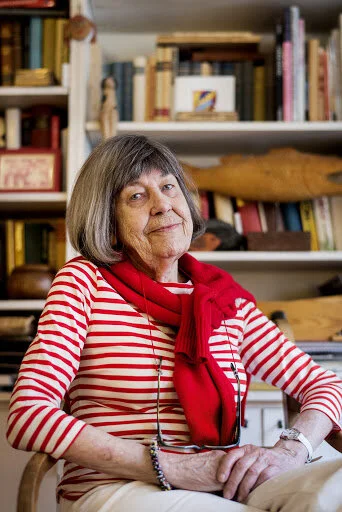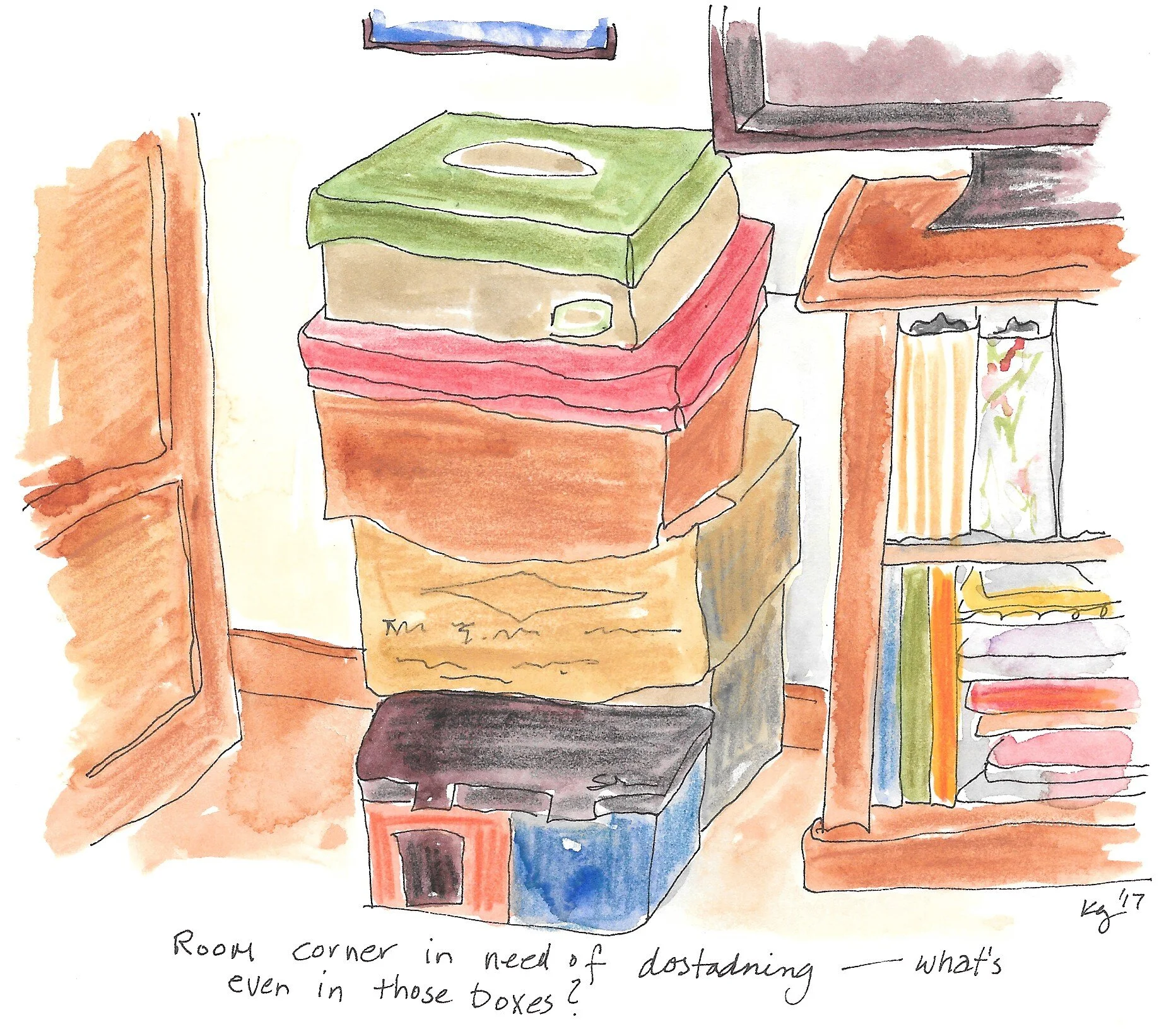My Ten Takeaways from Döstädning: The Gentle Art of Swedish Death Cleaning
When I first came across this little book a few years ago, I wasn’t eager to read it. The title put me off. I thought it was about some strange Scandinavian cleaning style and for those of you who know me well, you know cleaning isn’t really my thing. That’s one of the reasons I’m so passionate about KonMari and owning less…
Owning less stuff = less stuff to clean
But for me, I’ve discovered that this book isn’t about cleaning at all. It’s about decluttering in a thoughtful way and has many similarities with the KonMari Method. So I felt like I was in a safe place reading it!
Margareta Magnusson
The meaning of Döstädning is: ‘removing unnecessary things and making your home nice and orderly when you think the time is coming closer for you to leave the planet’. The author, Margareta Magnusson (who doesn’t tell us her exact age, only that she is between 80 and 100) shares all of her tips and wisdom from her experience of deciding what to do with items following the death of her mother, mother-in-law and her husband. She also shares how she is preparing her home to enable her children to deal with her things in a meaningful, less stressful way once she departs from this world to her final resting place. When I first researched the subject of the book, I thought the content would be sad and depressing. I couldn’t have been more wrong. The book is lively, humorous and insightful. When you’re reading it, for me it felt like Margareta was sat right across from me with a cup of tea sharing the story of her life. It’s a ‘cosy’ little book, and at times, a little tongue in cheek!
Here are my top ten takeaways from this lovely book…
1. Talking about death is taboo but death cleaning is a way to start the conversation in a subtle way: I know I’ve had many occasions in the past when I’ve visited my parent’s home and thought about the hours it would take me to go through everything when they pass away. But it’s something I automatically put to the back of my head. Starting the conversation with them about what they want to do with these items should they pass away is an unthinkable challenge! Thinking about death is hard. Talking about it is even harder. But this book does offer some guidance on how to broach the topic of getting things in order for when that time comes. Margareta shares some careful questions to ask family members to introduce the topic gently including ‘do you enjoy having all of these things?’, ‘have you thought about what you want to do with this stuff later on?’ and ‘is there any way I can help you with these items in a slow and meaningful way?’.
Increasingly, I am working with clients in their 60s who are downsizing because they want to live a more streamlined life. They’re not planning for death; they’re taking stock of their life content and using decluttering as an opportunity for reflection, which leads to a beautiful trip down memory lane.
2. Margareta’s fresh take on letting things go: In KonMari, we practice gratitude when we say goodbye to the items that have served us in our life but no longer have a place in our life. Letting go of items can be an extremely difficult process, that’s one of the reasons why many people require support from a KonMari Consultant or professional organiser. We’re trained to effectively explore the dialogue behind each item and help you to decide whether it’s worth keeping in line with your ideal lifestyle and living environment. Margareta recognises that letting go is difficult but she explains that it’s rewarding to spend time with these objects one last time, enjoying the history behind the items and the memories that are evoked. Her take is deeply rooted in gratitude and is surrounded with positivity. One of my favourite quotes from the book reveals how she feels about her home after completing her own death cleaning: ‘I have time to enjoy all that my apartment has to offer, which is a reflection of my life’.
3. Death Cleaning isn’t just for an older generation: You can use the guidance of this book at any age. The philosophy is centered around making life easier and less crowded. Margareta offers practical tips on how we can make our lives run more smoothly. One part that really resonated with me was her memory of how she once organised her entrance way in her family home to resemble a Swedish primary school. Each one of her children was assigned a colour, and they were given a cubby hole in that colour with a matching hook. This prevented all of her children’s items from entering the family living area. I have visions of creating a similar set up for Romeo and Hermione when they are fully immersed in school life in a few years time. The content of the book is particularly relevant for downsizers of any age, and can be a source of support for anyone, particularly if you’re going through a transitional stage in your life.
4. The moment you realise you have too much clutter: Some of the people I work with are very aware of the clutter in their homes, hence the reason they’ve reached out to me in the first place! But since reading The Gentle Art of Swedish Death Cleaning, I’ve been reminded of how clutter can build over time, without us actually being aware of it, particularly if we’re living busy lives. One part I loved was when Margareta discussed how people can have a aha-I’m-living-in-a-mess-and-this-isn’t-good moment when they feel relieved that someone has cancelled a dinner or trip to your home. If you’re feeling grateful for them cancelling, instead of disappointed, treat this as a wake-up call. Lots of my clients have admitted that they’re embarrassed when people show up unexpectedly because they don’t want them to see how messy and cluttered their home is. I wonder if you can relate to this?
5. Don’t leave the burden of organising your home to your children: One of the key lessons of the book is that we should take responsibility for our home and the items that exist in it now. Margareta tells us: ‘do not imagine that anyone will wish - or be able (as everyone is so busy these days) - to schedule time off to take care of what you didn’t bother to take care of yourself.’ When I first read this, I thought this was a brave warning. At first it sounds quite brutal but this book is a wake up call to those who think their things will magically sort themselves out when they are no longer here. Some of my own clients have already identified this and they’re easing the potential burden for their family members by reducing the amount they own. Furthermore, they are starting to determine where each item’s destination will be once they have passed away. Although this sounds quite morbid, in reality it’s a very joyful process. It goes much further than writing out a list in a will, which I will admit after completing my own will, isn’t the most joyous of activities.
Margareta shares how her own mother, who completed her death cleaning before she passed away, had left handwritten notes on specific items telling her family members which items were to be donated to charity, which were to be returned to specific individuals and even those that were to be given to the Museum of History (including the number of whom to telephone). Magareta tells us she felt consoled by these messages, instead of overwhelmed by them.
6. The ‘put it back’ basket or apron pocket: This was one of my favourite tips from the book and I can just see Margareta doing this! When she cleans, she wears an apron that has a large pocket at the front. Whenever she sees something that isn’t in its place, she puts it in her apron pocket and once it’s full, returns these things back to their designated home. If you don’t have an apron with a massive pocket, you can use a basket instead. These little tips making tidying and organising fun, like a scene out of a Disney movie (I’m thinking Cinderella or Enchanted!) but also allude to another key point: if you have so many misplaced items that they don’t fit into a basket or a pocket, then in Margareta’s words: ‘these households need immediate organisation’.
Would you buy a book that had handwritten messages inside?
7. Don’t be afraid of giving away books with notes in the margins: This point really struck a cord with me because I have been guilty in the past of holding on to books because I felt I’d written and doodled on them too much, therefore no one would want them! Margareta made me see it another way. She likes buying books that have notes written in them because it gives them extra character, and I have to agree… if I come across a note or piece of writing in a second hand book, I’m more intrigued rather than annoyed by it. Items can live in many places and this another good reason to reuse instead of always buy new in an increasingly consumerist world. To support my new found confidence in donating annotated books, I’m also reminded of three movies that have books with added character due to handwritten messages waiting inside:
Serendipity: Kate Beckinsale’s character writes her telephone number inside Love in the Time of Cholera for John Cusack to find her… if you know, you know!
Definitely Maybe: Ryan Reynold’s character tries to find a specific copy of Jane Eyre for Isla Fisher’s character because there is a handwritten message from her late father inside… what a film!
Harry Potter and the Half-Blood Prince: The handwritten messages in Advanced Potion Making from the Half-Blood Prince (spoiler: it’s actually Severus Snape) helped Harry to excel in his Potions class. Snape improved the recipes for various potions by amending procedures and scribbling notes in the margins.
That’s enough of showing off my movie knowledge for one post… The point is, I’m no longer fearful of donating books with my handwriting and illustrations in them!
8. You can enjoy things without owning them: Margareta tells us that through training ourselves to enjoy only looking at things, instead of buying them, is extremely satisfying and a good habit to adopt: ‘You really can’t take everything with you, so maybe it is better to try not to own it all.’ I said at the beginning of this post how reading the book feels like a 1:1 conversation with the author in a cosy little cottage somewhere… and it also takes me back to my very first job working for Marie Curie Cancer Care. Part of my role was to spark up conversations with the patients and I would spend hours listening to their stories, wisdom and anecdotes. Reading The Gentle Art of Swedish Death Cleaning felt like this. I read it within 24 hours (it’s only 127 pages and A5 in size) but I took so many tidbits away, in the same way you would when talking with your favourite, enigmatic older family member. Perhaps my most memorable tidbit from Margareta (which also fits in nicely with my love of history) was how the Vikings were buried with many objecys they had owned in their lives. She warns us that if this was still common practice today, we’d all need an Olympic size swimming pool for each of our graves! I told you parts of the book are slightly tongue in cheek (but funny too).
9. How it is common practice in Sweden to have a fulskap, otherwise known as ‘a cabinet for the ugly’: This was part of the book that made me laugh out loud because I’ve seen these types of spaces in so many of my client’s homes but they’ve never been given an actual name! Margareta tells us that a fulskap is cupboard full of gifts that you can’t stand to look at but which are also impossible to re-gift! They’re often from distant family members like an aunt or uncle who don’t seem to know us very well. She also warns us to be careful of displaying these items if ever those family members come to visit because if they see them on display, they will only buy you more! I hope I’ve convinced you by now that this book is full of humour and not at all sad!
10. The key question to ask yourself when you’re death cleaning is ‘will anyone I know be happier if I saved this?’ In KonMari, we have a baseline question to start our inner dialogue: ‘Does this spark joy?’. This question allows us to reflect on whether we want to keep an item or let it go with gratitude. In Death Cleaning, we ask a similar question but we also consider the people in our lives. When we go through our things, at times it can be useful to look towards the long term when deciding whether it should still have a place in our lives. We all have our own reasons for holding on to items. Margareta warns us that there is no sense in keeping things that will shock or upset your family members after you are gone. She is referring specifically to letters, documents and dairies that contain embarrassing stories and information. If you are unable to part with items of this nature for the time being, she has another suggestion: the ‘throw away’ box. This is a box you store these items in and when you’re gone, it has a very direct instruction for your family members to destroy/get rid of the contents without looking inside. Athough I like this idea, I feel that I’d like to take responsibility to dispose of these items myself. This part of the book reminded me that I still have my own diaries that I wouldn’t like my children to read. They are still in my life because I am planning to take the time to read them one last time before saying goodbye. I aim to do this within the next two years.
I hope you’ve enjoyed my ten takeaways from this insightful little book of wisdom. It really does offer a fresh perspective on a topic I have not read about before. Like the Life-Changing Magic of Tidying, it may lead you to a whole new trail of thinking and actions moving forward. I’m so glad Margareta Magnusson decided to complete her death cleaning so she was able to write this book!
Are you planning on reading The Gentle Art of Death Cleaning? Or have you already read it? I’d love to hear your thoughts in the comments below…





